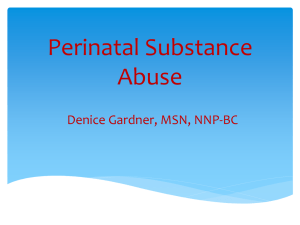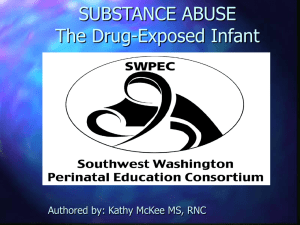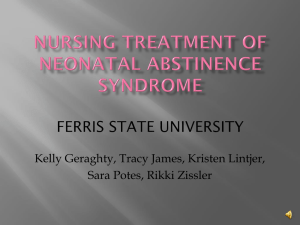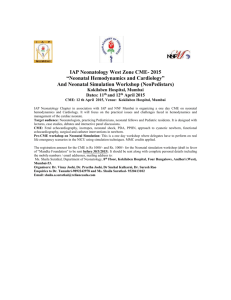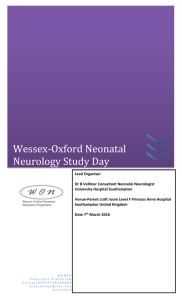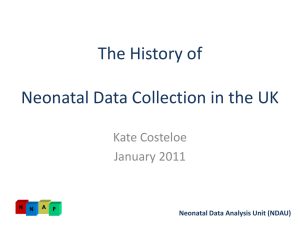exemplar 4 - Danielle Ciambor
advertisement
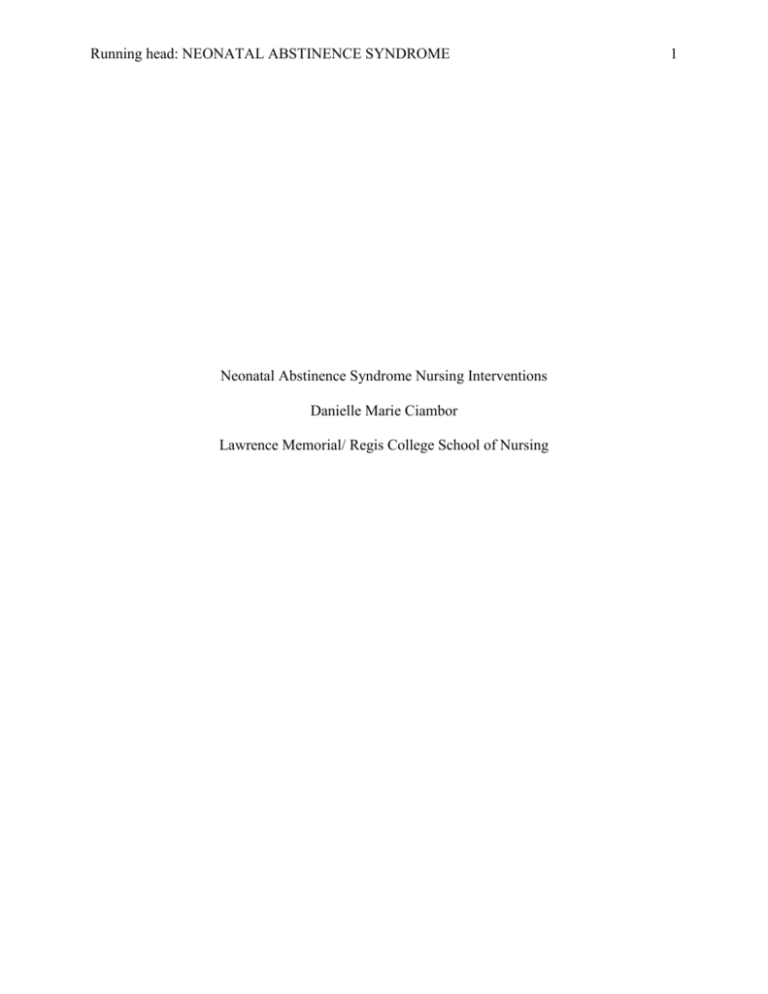
Running head: NEONATAL ABSTINENCE SYNDROME Neonatal Abstinence Syndrome Nursing Interventions Danielle Marie Ciambor Lawrence Memorial/ Regis College School of Nursing 1 NEONATAL ABSTINENCE SYNDROME 2 Neonatal Abstinence Syndrome Nursing Interventions Neonatal abstinence syndrome is a newborn narcotic withdrawal disorder and can occur when a woman takes narcotics such as methadone, buprenorphine, codeine, oxycodone or heroin during pregnancy. This disorder can affect the newborn’s breathing, nervous, and digestive systems. The symptoms are inconsistent and may include breathing problems, seizures, poor feeding, tremors, irritability, excessive crying, fever, diarrhea and vomiting (National Institutes of Health [NIH], (2014). In the United States, neonatal abstinence syndrome is an epidemic of growing proportion. This has brought upon a major challenge for prenatal nurses on how to clinically manage the symptoms of the ever growing population of newborns affected with neonatal abstinence syndrome (Saunders et al., 2014). In response to the epidemic, standardized nursing interventions need to be implemented to provide more effective care. The following discussion will include an annotated bibliography on neonatal abstinence syndrome nursing interventions. Annotated Bibliography McQueen, K.A., Murphy-Oikonen, J., Gerlach, K., & Montelpare, W. (2011). The impact of infant feeding method on neonatal abstinence scores of methadone-exposed infants. Advances in Neonatal Care, 11(4), 282-290. doi: 10.1097/ANC.0b013e318225a30c The authors investigated if the feeding method could make a difference on the neonatal abstinence syndrome scores of newborns exposed to methadone in utero. The study compared newborns who were solely bottle fed, combination fed (formula and breast milk), or exclusively breast fed by analyzing if newborns experienced reduced symptoms of neonatal abstinence syndrome when methadone was provided through breast milk. The purpose of the research was to verify if feeding methods altered neonatal abstinence syndrome scores of newborns subjected to methadone in utero. There were several NEONATAL ABSTINENCE SYNDROME 3 limitations of the research; however, the most detrimental was the small group size of 28 newborns. Further research that could be done to expand knowledge in this area is to discover if there are any valuable interventions to initiate and sustain breastfeeding in methadone-maintained mothers. The conclusion of the study was methadone-maintained mothers who breast feed their newborns, along with other benefits, may reduce severity and duration of neonatal abstinence syndrome. The main practice implication that relates to this study is teaching in the prenatal period for methadone dependent mothers regarding the benefits of breastfeeding for both mother and infant. Comparing this article with the other sources referenced, a difference is this source specifically targeted methadone exposed newborns. This is a useful source for specifying what feeding method should be recommended to new mothers who are maintained on methadone. Pritham, U.A., Paul, J.A., & Hayes, M.J. (2012). Opioid dependency in pregnancy and length of stay for neonatal abstinence syndrome. Journal of Obstetric, Gynecologic & Neonatal Nursing, 41(2), 180-190. doi: 10.1111/j.1552-6909.2011.01330.x This article explores what factors affect the length of stay for newborns who are exposed to opioid replacement therapy and other concurrent prenatal exposures. The study was about determining the length of stay for newborns with neonatal abstinence syndrome due to mother’s methadone or buprenorphine maintenance therapy and other factors such as use of tobacco, alcohol, SSRIs, benzodiazepines, marijuana, other opioids and feeding method. The objective of this research was to examine opioid replacement therapy and other variables in pregnancy. The research also observed outcomes of infants with neonatal abstinence syndrome, including length of stay. There were several limitations of NEONATAL ABSTINENCE SYNDROME 4 the research; however, the most unfavorable was the unequal size of the buprenorphine and methadone groups. Further research that could be done to expand knowledge in this area is to determine the differences in neonatal abstinence syndrome in relation to initial exposure and gestational age, along with the duration of exposure to opioid replacement therapy. The conclusion of this study is the concurrent use of tobacco, alcohol, SSRIs, benzodiazepines, marijuana, and other opioids with opioid replacement therapy, during pregnancy may impact the expression of neonatal abstinence syndrome and even exacerbate the withdrawal symptoms. A major implication for practice is collaboration between prenatal care providers, psychiatrists and addiction treatment specialists to collectively emphasize alternatives that are non-pharmacologic to decrease any unwarranted fetal exposure. In comparison to the other sources referenced, this study broadened their scope of research to include other factors that would perpetuate neonatal abstinence syndrome. This is a helpful source in identifying key factors, beside opioid replacement therapy, that increase the length of stay for neonatal abstinence syndrome infants. Saunders, C., King, T., Smith, S., Buchheit, J., Cook, K., Edds, J., & Mefford, L. (2014). Neonatal abstinence syndrome: Evaluating the effectiveness of an evidence-based multidisciplinary care approach. Journal of Perinatal & Neonatal Nursing, 28(3), 232240. doi: 10.1097/JPN.0000000000000049 The authors evaluated if the evidence based multidisciplinary neonatal abstinence syndrome protocol reduced the length of stay, weaning time from opioids and the use of supplemental pharmacotherapy in newborns diagnosed with neonatal abstinence syndrome. The study was about the development of the evidence-based multidisciplinary NEONATAL ABSTINENCE SYNDROME 5 protocol and also to assess the effectiveness. The objective of the research was to evolve a neonatal abstinence syndrome protocol using a stepwise continuous quality improvement technique with the ultimate goal of standardizing care procedures for neonatal abstinence syndrome newborns. A major limitation of the study was strict control of confounding variables were unattainable due to rapid cycles of change. Further research that could be done is to examine long term developmental and behavioral outcomes of the children and family treated with the neonatal abstinence syndrome protocol. The conclusion of the study was to use a multidisciplinary approach when caring for families with a neonatal abstinence syndrome diagnosed newborn, this addressed the complex and dynamic care needs of both the family and the patient. A major implication for practice is the research provided a protocol to follow for a newborn diagnosed with neonatal abstinence syndrome that also included the family. Compared to the other sources referenced, one of the major differences was the authors developed a neonatal protocol, also the number of participates was much higher than those without an established protocol. This research was useful in identifying specific evidence-based nursing interventions. Conclusion The referenced sources aided in understanding the topic of nursing interventions for neonatal abstinence syndrome, by providing evidence-based research. The studies found compelling evidence to assist opioid-dependent mothers during prenatal care and also the antepartal period to reduce the outcomes of neonatal abstinence syndrome. The findings enable NEONATAL ABSTINENCE SYNDROME 6 nurses to narrow down tasks that they can perform to decrease the symptoms of neonatal abstinence syndrome, which then decrease the length of stay for the infant. Due to the ever growing population of infants born with neonatal abstinence syndrome, evidence-based standardized nursing interventions need to be put into place to help decrease the symptoms of neonatal abstinence syndrome. This would decrease the length of stay in the hospital, which would hopefully, not put as much of a burden on the United States health care system as it does today. Also, if there were standardized nursing interventions to follow, nurses may feel a decreased burden when caring for an infant with neonatal abstinence syndrome. The new knowledge acquired from these studies help future nursing practice by pointing out steps of care to follow when treating an infant for neonatal abstinence syndrome. The studies also highlight a missed opportunity to decrease the number or severity of infants born with neonatal abstinence syndrome. Nurses could be available, at opioid replacement maintenance programs, to offer education to pregnant women who are enrolled in the program. The nurse could also share community resources to newly pregnant women, in hopes that they would receive proper prenatal care. Education is an important aspect of this complex syndrome and is imperative throughout the course of pregnancy and if possible, even before conception. NEONATAL ABSTINENCE SYNDROME References McQueen, K.A., Murphy-Oikonen, J., Gerlach, K., & Montelpare, W. (2011). The impact of infant feeding method on neonatal abstinence scores of methadone-exposed infants. Advances in Neonatal Care, 11(4), 282-290. doi: 10.1097/ANC.0b013e318225a30c National Institutes of Health. (2014). Retrieved from http://www.nlm.nih.gov/medlineplus/ency/article/007313.htm Pritham, U.A., Paul, J.A., & Hayes, M.J. (2012). Opioid dependency in pregnancy and length of stay for neonatal abstinence syndrome. Journal of Obstetric, Gynecologic & Neonatal Nursing, 41(2), 180-190. doi: 10.1111/j.1552-6909.2011.01330.x Saunders, C., King, T., Smith, S., Buchheit, J., Cook, K., Edds, J., & Mefford, L. (2014). Neonatal abstinence syndrome: Evaluating the effectiveness of an evidence-based multidisciplinary care approach. Journal of Perinatal & Neonatal Nursing, 28(3), 232240. doi: 10.1097/JPN.0000000000000049 7
